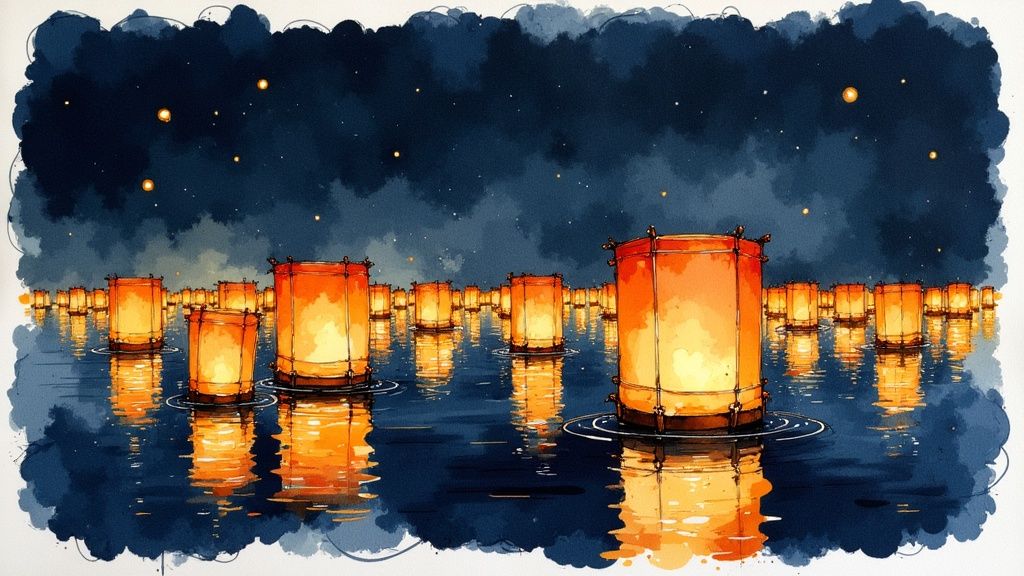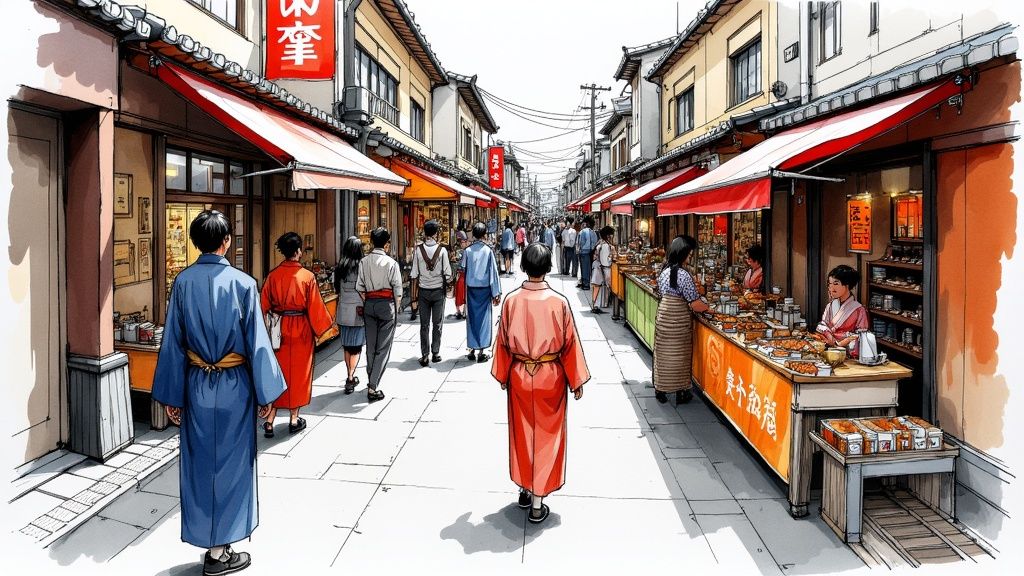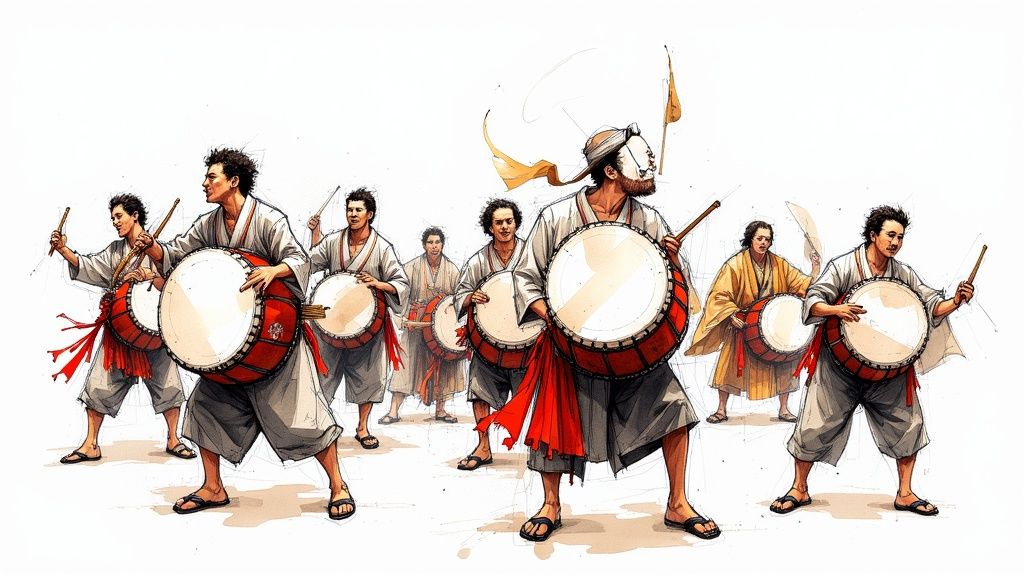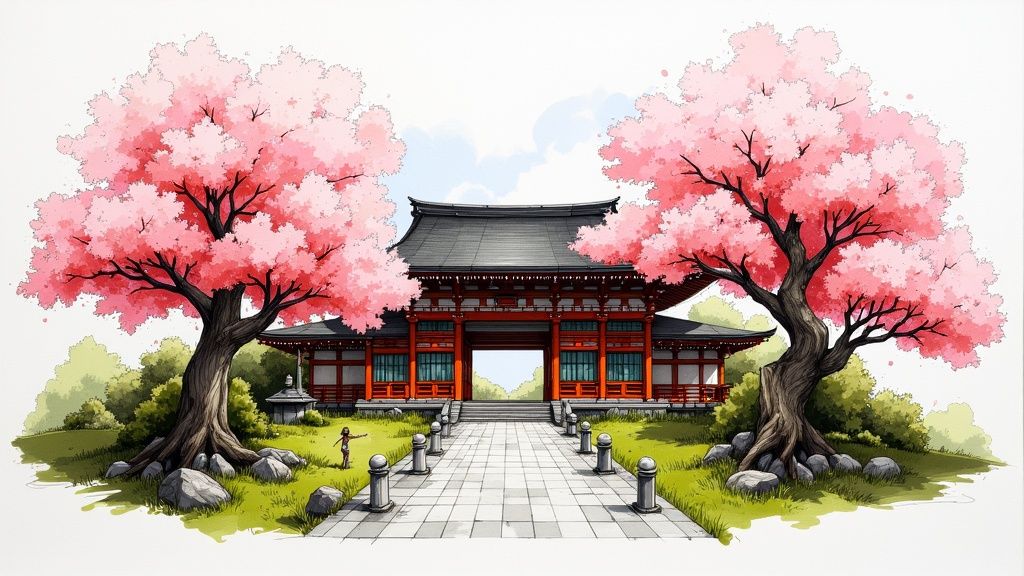Understanding the Heart of Japanese Festival Culture

Over 200,000 Japanese festivals take place each year across the country, bringing communities together to celebrate and preserve cherished traditions. These festivals, known as "matsuri" in Japanese, go far beyond simple celebrations – they help shape local identity and keep cultural practices alive for future generations. The impact of these festivals is significant, generating around 530 billion yen annually while fostering deep community connections.
The Cultural Significance of Matsuri
Japanese festivals beautifully weave together the old and new. Many festivals maintain their historical roots in Shinto and Buddhist practices through traditional rituals and processions that have endured for centuries. At the same time, these events have naturally grown to include modern elements like popular music, contemporary food stalls, and new forms of entertainment. This organic blend of tradition and modernity helps matsuri remain meaningful and engaging for people of all ages.
Preserving Heritage Through UNESCO Recognition
The global community has acknowledged the special role of Japanese festivals in preserving cultural heritage. Thirty-three matsuri have earned spots on UNESCO's Intangible Cultural Heritage Lists under the category "Yama, Hoko, Yatai, float festivals in Japan." This recognition does more than validate their importance – it helps share these vibrant traditions with people worldwide and ensures they continue for generations to come.
Community and Identity in Festival Celebrations
These festivals bring people together in powerful ways. Local residents work side by side to prepare intricate floats, create costumes, organize performances, and set up food stalls. Through this shared effort, neighbors strengthen their bonds and sense of belonging. The festivals become a source of pride, highlighting what makes each community special while connecting people to their shared history and traditions.
The Economic Impact of Traditional Festivals
The benefits of these cultural celebrations extend throughout local economies. Major events like the Aomori Nebuta Matsuri draw over 2 million visitors, while the Tokushima Awa Odori attracts more than 1 million people annually. This influx of tourists supports hotels, restaurants, shops, and transportation services in host communities. The economic boost helps preserve these beloved traditions while sustaining the towns and cities that keep them alive. As Japanese festivals continue adapting and evolving, they remain vital threads in the fabric of both community life and the national economy.
Inside Japan's Most Spectacular Festival Experiences

Japanese festivals offer some of the most captivating cultural experiences you can find. From towering illuminated floats to spirited dance performances, these celebrations bring communities together in remarkable ways. Let's explore three of Japan's most famous festivals: the Aomori Nebuta Matsuri, Tokushima Awa Odori, and Kyoto Gion Matsuri – each offering its own unique window into Japanese traditions and community spirit.
Aomori Nebuta Matsuri: A Spectacle of Light and Sound
Every August, over two million people gather in Aomori for one of Japan's largest festivals. The main attraction? Massive illuminated floats called "nebuta" that parade through the city streets each night. Local artists spend months crafting these impressive structures from washi paper and bamboo, bringing Japanese mythology and historical figures to life through meticulous detail. As the floats process through town, the air fills with thundering taiko drums and crowds chanting "Rassera, Rassera!" The combination of glowing floats, pulsing rhythms, and shared excitement creates an unforgettable atmosphere that connects everyone present, whether local or visitor.
Tokushima Awa Odori: The Dance of Fools
Down in Tokushima prefecture, August brings a very different kind of celebration – the lively Awa Odori dance festival. Known affectionately as the "Fool's Dance," this event draws a million spectators to watch groups of dancers called "ren" move through the streets in perfectly coordinated routines. Dressed in colorful yukata and straw hats, the dancers flow with grace and energy to traditional music. What makes Awa Odori special is how it welcomes everyone to join in – you don't need any dance experience to participate. This open spirit turns observers into participants, creating a joyful celebration that brings the whole community together.
Kyoto Gion Matsuri: A Month of Tradition
While many festivals pack their excitement into a few days, Kyoto's Gion Matsuri unfolds throughout July, showcasing the depth of Japanese festival traditions. The highlight comes with a grand parade of ornate floats called "yama" and "hoko" – some reaching several stories high. These impressive structures showcase intricate decorative arts, from detailed carvings to fine textiles. But the Gion Matsuri is about more than spectacle. It represents months of preparation by skilled craftspeople and dedicated community members working together. Through carefully preserved ceremonies and rituals, the festival connects modern participants to centuries of Kyoto's cultural heritage. Visitors get to experience these authentic traditions firsthand rather than just observe them.
These three festivals reveal different facets of Japan's festival culture, each offering meaningful ways to connect with Japanese traditions. Whether watching the glowing nebuta floats, joining the Awa Odori dances, or taking in the month-long ceremonies of the Gion Matsuri, these celebrations show how festivals strengthen community bonds and pass cultural practices from one generation to the next. The chance to participate in any of these festivals provides deep insight into the role celebrations play in Japanese society.
The Essential Elements That Define Traditional Matsuri

Japanese festivals, known as matsuri, captivate visitors with their lively celebrations like the energetic Awa Odori dance festival and the spectacular Aomori Nebuta Matsuri. But beyond the excitement and spectacle, these festivals carry deep meaning as living expressions of Japan's cultural heritage. Let's explore the key elements that give matsuri their distinctive character and cultural importance.
The Mikoshi: A Sacred Journey
At the heart of many matsuri is the mikoshi – a portable shrine that serves as a temporary home for Shinto deities. Local community members work together to carry these ornate structures, which often weigh several hundred pounds, through the streets in a powerful display of devotion. The Gion Matsuri in Kyoto showcases this tradition beautifully, with grand mikoshi processions that have remained true to their origins across centuries. As participants bear the weight of the shrine on their shoulders, they strengthen their connection to both their community and their spiritual traditions. This physical act of carrying the divine through the streets remains one of the most meaningful aspects of Japanese festivals.
The Rhythm of Taiko Drums: A Cultural Heartbeat
No matsuri would be complete without the thundering sound of taiko drums echoing through the streets. These traditional drums come in many sizes and styles specific to different regions of Japan. The intricate rhythms played on them do more than just provide a soundtrack – they tell stories passed down through generations, expressing the emotions and traditions unique to each local community. When the drums begin to play, their powerful beats unite the crowd in shared excitement and celebration. The taiko's rhythms truly capture the spirit that makes each festival special.
Traditional Performances: Preserving Ancient Stories
The performances at matsuri keep Japan's rich folklore and mythology alive for new generations. From the graceful movements of Bon Odori dances during Obon season to dramatic Noh and Kyogen theater productions, these shows blend music, dance, and elaborate costumes to share cultural stories. Beyond pure entertainment, they serve as living history lessons that pass down important values and traditions. Through these carefully preserved performances, matsuri create a bridge between Japan's past and present.
Festival Attire: Symbolism and Significance
The clothing worn during matsuri carries deep cultural meaning. From lightweight summer yukata to the detailed costumes of performers, each garment choice reflects specific festival traditions. The happi coats worn by many participants feature designs that represent their local community or the particular celebration. These thoughtfully chosen outfits help create the special atmosphere of matsuri while expressing cultural identity. When combined with other elements like the mikoshi processions and performances, the traditional clothing helps make Japanese festivals truly unique cultural experiences that continue to captivate participants and spectators alike.
Exploring Regional Festival Diversity and Community Impact

Across Japan, traditional festivals showcase the country's rich cultural diversity. Each region puts its own unique stamp on these celebrations, reflecting centuries of local history, spiritual beliefs, and natural surroundings. The Aomori Nebuta Matsuri perfectly demonstrates this local character – its massive washi paper and bamboo floats bring ancient legends to life through skilled craftsmanship. Meanwhile, in Tokushima, the Awa Odori festival pulses with the distinct rhythms and dance moves that have defined that region's artistic expression for generations.
Showcasing Regional Identity Through Festivals
These festivals provide a natural stage for communities to display what makes them special. At Kyoto's Gion Matsuri, parade floats feature exquisite local textiles and woodcarvings that highlight the city's artistic heritage. Food also plays a central role, with regional specialties prepared using time-tested methods handed down between families. When communities come together to share these unique traditions, it builds a deep sense of local pride and belonging.
The National Cultural Festival: A Celebration of Diversity
Japan's commitment to preserving regional traditions is evident in events like the National Cultural Festival. This yearly gathering rotates between prefectures, bringing together performers and artisans from across the country. The 2023 festival in Okinawa drew 1.28 million people over 44 days, proving how these celebrations can unite communities while honoring their distinct cultural identities.
Community Impact and Economic Benefits
These festivals do more than preserve culture – they breathe life into local communities. Different generations work side by side to plan and carry out festival activities, passing down knowledge and strengthening social bonds. The events also provide significant economic support through tourism. For example, the Aomori Nebuta Matsuri brings in over 2 million visitors annually, generating income that supports both the festival tradition and the broader community. You might be interested in: Must-See Japanese Cultural Festivals.
Preserving and Adapting for the Future
While staying true to their roots, festivals must also grow and change to remain relevant. Many communities are finding creative ways to involve young people and incorporate new elements that complement traditional practices. They're also developing approaches to manage tourism sustainably. This careful balance between honoring the past and embracing the future helps ensure these festivals continue to enrich their communities for generations to come.
Mastering the Art of Festival Foods and Traditions
Japanese festivals offer much more than dazzling sights and sounds – they're immersive cultural experiences centered around cherished foods and traditions. By understanding and participating in these customs, visitors can discover the deeper meaning and spirit behind these joyous celebrations.
Savoring the Flavors of Matsuri: A Culinary Journey
Food sits at the heart of Japanese festival culture, with each region and season bringing its own special dishes to the festivities. At the Aomori Nebuta Matsuri, the salty ocean breeze carries the aroma of grilled seafood caught fresh from local waters. These regional specialties tell stories of local history and identity through flavors passed down over generations.
The foods themselves often carry meaningful symbolism. Sweet rice dumplings called dango represent community bonds and togetherness when shared among festival-goers. Learning about these food traditions adds richness to the experience, helping visitors understand the cultural values woven into each bite.
Traditional Games and Activities: A Celebration of Heritage
Games and activities at Japanese festivals teach cultural lessons through play and interaction. The delicate art of kingyo-sukui (goldfish scooping) requires focus and gentle movements – qualities highly valued in Japanese culture. Meanwhile, drawing omikuji fortunes connects visitors to ancient spiritual practices still meaningful today.
Participating in Dances and Ceremonies: Embracing the Spirit of Matsuri
Getting involved in festival dances and ceremonies creates lasting memories and cultural connections. The Bon Odori dance brings people together during Obon season to honor ancestors through synchronized movements. As dancers move as one to traditional rhythms, they share in an experience that transcends language and cultural barriers.
Etiquette and Cultural Context: Navigating the Festivities
Understanding proper festival manners shows respect and enables deeper participation. Wearing traditional summer yukata robes helps visitors feel part of the festivities while honoring customs. Knowing the meaning behind sacred elements like the mikoshi shrine procession allows guests to appreciate key moments with cultural awareness.
When visitors embrace festival foods and traditions fully, they move beyond being mere observers to become active participants in living cultural heritage. This deeper engagement creates meaningful memories and authentic cultural exchange that captures the true spirit of Japanese festivals.
Safeguarding Festival Heritage for Tomorrow
Japanese festivals, or matsuri, captivate visitors with their rich traditions and vibrant celebrations. Beyond their present-day appeal lies the essential task of keeping these cultural practices meaningful for future generations. This requires finding ways to preserve core traditions while thoughtfully adapting to modern needs.
The Role of UNESCO and Preservation Initiatives
The inscription of 33 Japanese matsuri on UNESCO's Intangible Cultural Heritage list highlights their worldwide importance. The Yama, Hoko, Yatai float festivals, for example, have gained vital international support since their recognition. But preservation goes far beyond simply maintaining existing practices. Communities actively document festival preparations, music, dance steps, and crafting techniques – much like passing down cherished family recipes to ensure their flavors live on through generations.
Technology's Contribution to Cultural Preservation
Modern tools help protect festival traditions in practical ways. High-quality video recordings capture intricate details of float construction and ceremonial dances, creating lasting records even as physical objects age. Online platforms also allow communities to share their festivals with people worldwide, building appreciation while documenting practices for future reference.
Engaging Youth and Ensuring Future Participation
Getting young people involved is essential for festivals to thrive. Many communities now include special activities and workshops that help children connect with local traditions. Some festivals give youth smaller organizational roles, letting them learn hands-on while developing pride in their cultural heritage. This shows how festivals must grow and change to stay relevant, rather than becoming static displays of the past.
Balancing Tradition and Modernity in Promotion
Sharing Japanese festivals with global audiences requires careful consideration. While promoting these events is important, it must be done respectfully to protect their cultural meaning. Communities need support to manage tourism sustainably and minimize negative impacts. Clear visitor guidelines and educational materials help tourists appreciate festivals as authentic cultural experiences rather than just entertainment.
By combining preservation work, new technology, and youth involvement, Japanese communities are actively sustaining their matsuri for the future. This thoughtful approach helps festivals remain true to their roots while evolving naturally with each new generation.
Are you fascinated by Japanese culture and the traditions behind matcha tea? Explore the rich heritage and discover more about Japanese festivals and traditions at matcha-tea.com.
